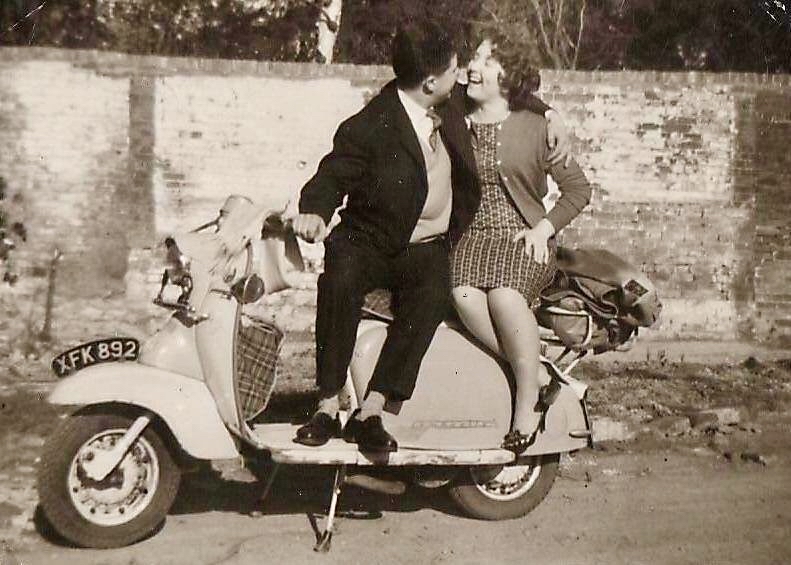
I feel privileged to post this image from my new online pal Steve Morris – of his Mum and Dad on their Lambretta. This photos captures a perfect instant of joy! Steve has a fantastic Lambretta collection that I’m going to post more about soon!

Love this period pic from the ’50s of people turning out to watch some kind of motorcycle, or possibly scooter race. I love the way all their bikes, and scooters are ‘parked!’
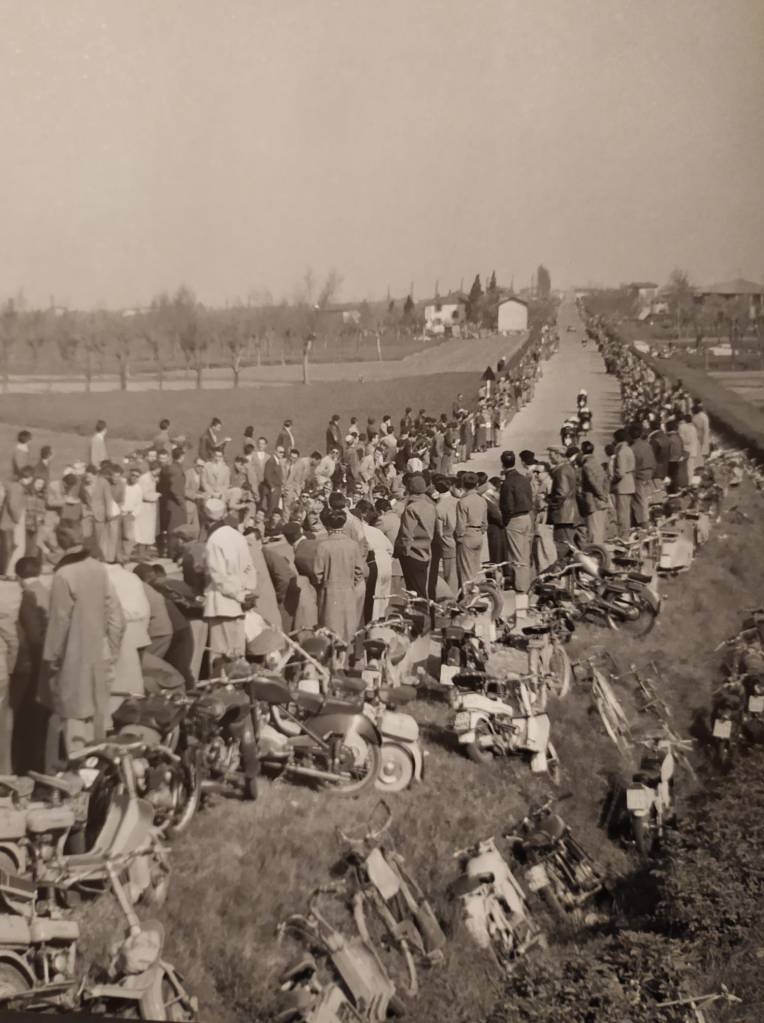
Thanks to Daz for sending me the pic
UPDATE: I’ve been informed, in the comments that this is a pic of the 1954 Moto Giro d’Italia – which certainly fits with the Lambretta models on display. If you’ve got any further info on any of my posts – I’ve missed something out, or got something wrong, let me know in the comments, and I’ll update it!
This is a fantastic story of the restoration of a Lambretta FC, built to sell ice-cream – and now magnificently restored to it’s former glory. And what could be more Italian than Lambrettas AND Ice Cream?

Firstly, a bit of background. As well as providing affordable, stylish post-war transportation, the Lambretta was an exceptionally versatile ‘platform’ for small commercial vehicles. In addition to – and before we saw the Lambro range of light commercial vehicles – that I’ve written about before here – there was a wide range of “cab-less” vehicles – these date back to the earliest days of Lambretta – The first FA’s being exhibited at the Milan trade fair back in 1948. The “F” designation stands for “Furgone” (Italian for van) – and here things may get a little confusing – as Lambretta later launched a “F” model, in line with their alphabetical naming policy – but these early commercials (the FA, the FB and FC) preceded that, and were based on the Model A, B and C’s respectively.
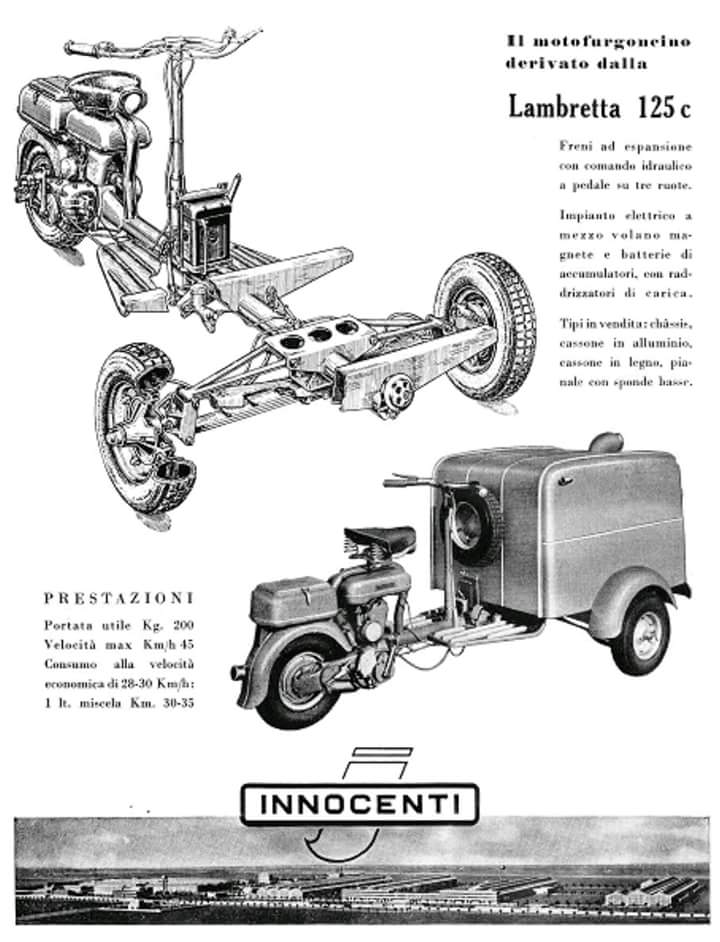
The FC was a bit of a hybrid of the C and LC model – the scooter body basically a model C, but with the engine and cooling systems from the LC. As with the FA and FB models, the FC was configured with a ‘box’ at the front, with two wheels either side – with the power from the 125cc engine going to the single wheel at the back – the later Lambro’s adopted a different layout (single wheel at the front, cabin, box behind the driver, power going to the two rear wheels.

Enough background information. More than enough. Back to this particular machine! This magnificent scooter (a FC) is owned by Bruno Strigini – a lifelong Lambretta enthusiast – who discovered it and restored it to it’s former glory.

Bruno bought the Lambretta FC 1998. It was the second of four three-wheelers owned by the Galbiati family, the previous one, an FB model is now in Vittorio Tessera’s Lambretta museum. In the original documentation he got when he bought it, it shows it’s intended use was always to sell ice-cream – and it was approved as such. As you will see from the image above, it was in reasonably complete condition, just a little the ‘worse for wear”.
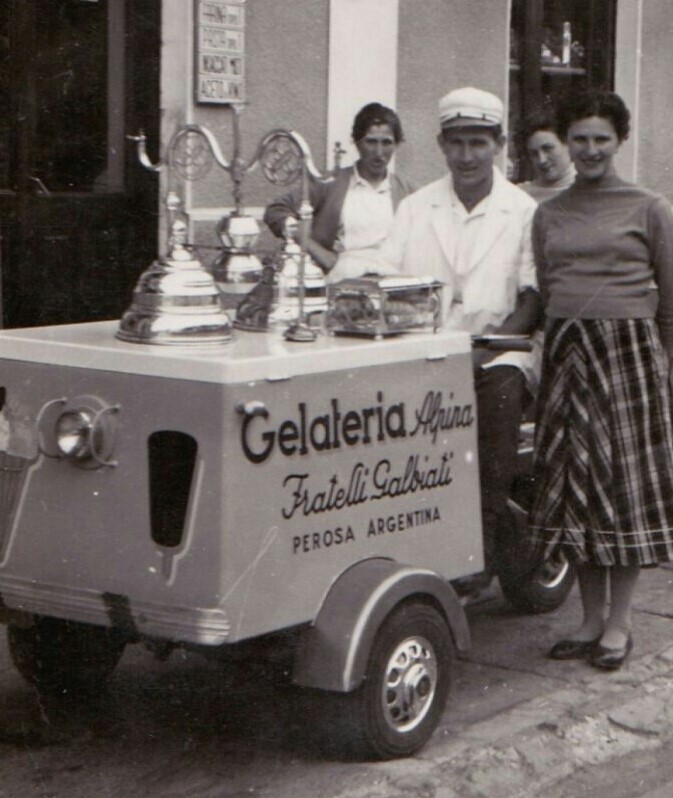
What was intact though was the fantastic original signwriting – including the name of the town the “Galbiati Brothers” were based – Perosa Argentina (a municipality near Turin in North West Italy, and not the South American country!). Galbiati’s plied their trade between Perosa Argentina – a municipality near Turin, and the Italian ski resort of Sestriere, about 40km away.
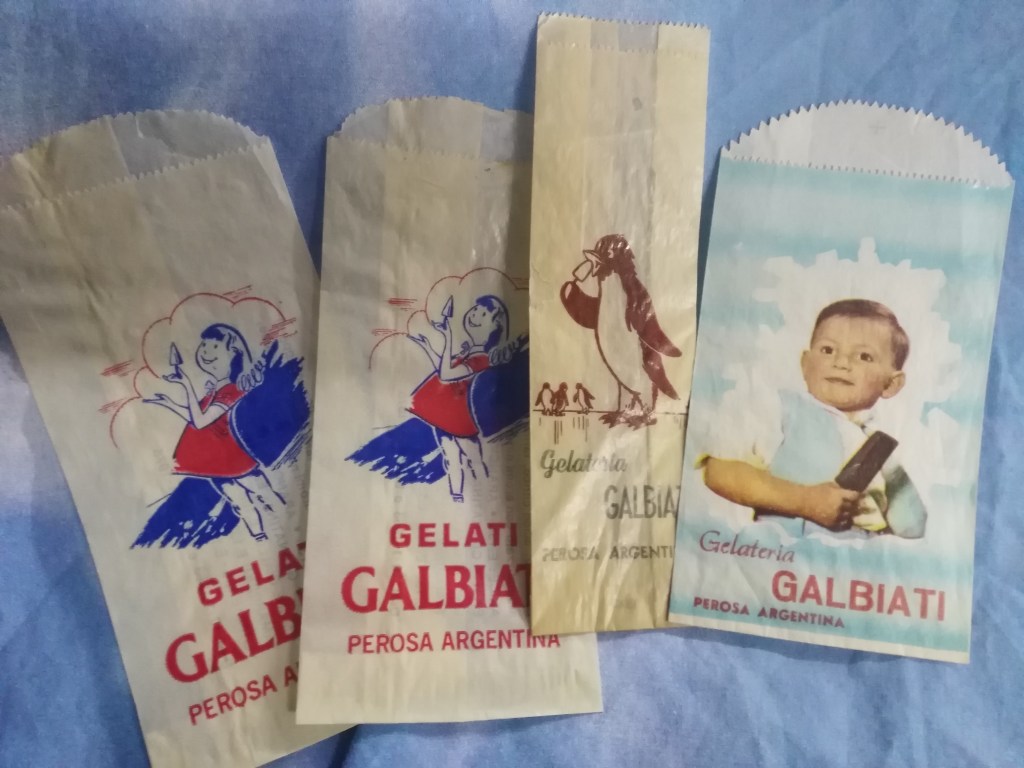
Bruno was lucky enough to meet the original owner, Sr. Galbiati, and stayed with him for an afternoon in 1998. Since then, he’s been in contact only with his daughter, who gave him the original photos featured here, and the original cork tubs where she made ice cream. Originally, the ice-cream was kept cold with a mixture of ice and salt, but Bruno designed a modern cooling system that preserved the original wooden box. It can now hold 32kg of ice cream in four flavors, and is equipped with a battery-powered compressor that can maintain -20 degrees Celsius for two days independently.

Bruno has done a done a magnificent job restoring this wonderful machine to it’s former glory, and it’s fully functional as it’s original purpose. It’s clear that he really cares about the story of the machine – telling me he regards it as ‘part of the family’. It’s great to see a machine with such a heritage of the scooter, an important, slightly forgotten part of Lambretta history.
I’ll close this post with apologies to Bruno, who sent me this story and the fabulous pics, some time ago now. While Lambrettas are my passion, and I love working on this blog, between work and family commitments, I sometimes I just can’t seem to find them time to update it as often as I would like to! Bruno also owns the “daddy of all Lambretta commercials” an FA model, but that’s another story for another day, and another post!
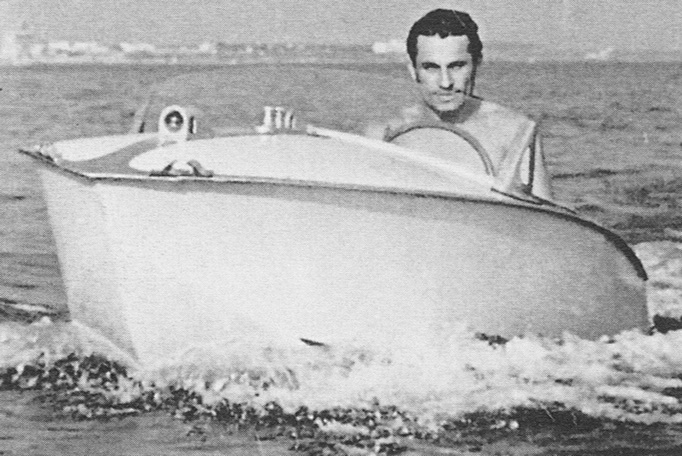
As Monty Python used to say, “Now for something completely different!” – The Lambretta del Mare – or “Lambretta of the Sea” . Now I’ve featured various “amphibious” Lammies before (here and here) but never a fully fledged Lambretta powered boat before!

The Lambretta del Mare was a pleasure boat built by SARA of Rome. It was shown at the 1950 Milano Fiera trade show in the Montecatini Pavilion. The pleasure boat was powered by a LC 125 Lambretta engine.

Described as ‘elegant and easy to drive’ and ‘the most comfortable and most modern motorboat’ ‘The Lambretta del Mare allows navigation even with very rough sea. The great maneuverability, the shape and lightness of the hull give it remarkable stability and safety qualities. I used an innovative “Peralum” aluminum body produced by Montecatini making it extremely resistant to corrosion.


Those of you with better Italian than I can probably discover more from the brochure featured above… but it starts off saying something like… “Today, for the first time in the world, we are presenting a nautical vehicle; the “Lambretta del Mare” which allows a large number of the public to achieve an aspiration considered unattainable so far due to the high purchase price and the difficulty of transport and shelter” So – I’m assuming it was quite affordable – easy to transport – and to store – as it goes on to say the boat would fit in a standard size garage.
I wonder if this actually made it into manufacturing? And if so, how many of these actually made… which begs the question… do any still exist? It would be the ultimate addition to any Lambretta collection!
Thanks again to regular Lambrettista contributor Darrin Slack for finding and sharing these images!
I have a credit for the top photo… if I have to credit anybody else, please let me know.
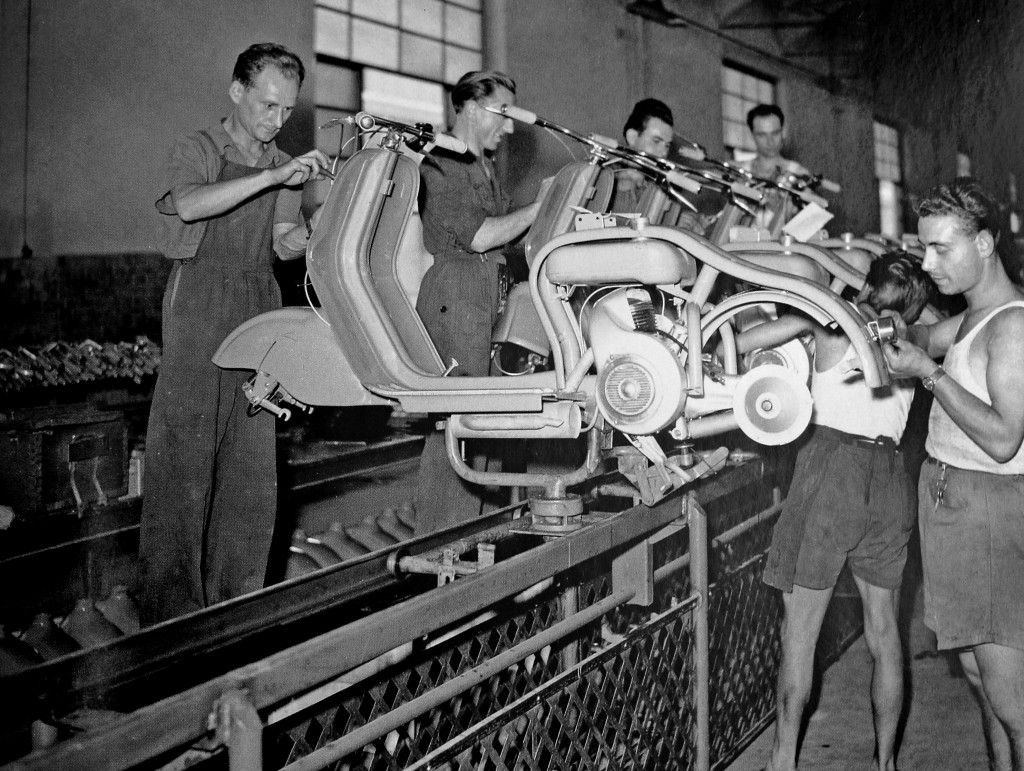
Following my post from the Spanish Lambretta / Serveta factory in Eibar, (here) I’ve been sent a ton of fantastic imagery from my online pal Darrin Slack – so much that they will be providing the majority of the posts for the forseeable future – my only issue is finding enough hours in the day to post them! Darrin is a self-admitted ‘bloody bloohound’ when it comes to anything Lambretta – and has scoured the internet to find these images – which kinda what I’ve been doing for to find content for this blog – but Darrin is far better at it than I am! So, all this stuff is out there on the internet already, but it’s nice for us Lambretta fans to have everything in one place eh? Hopefully this blog becomes a bit of a resource for anybody interested in Lambretta history.
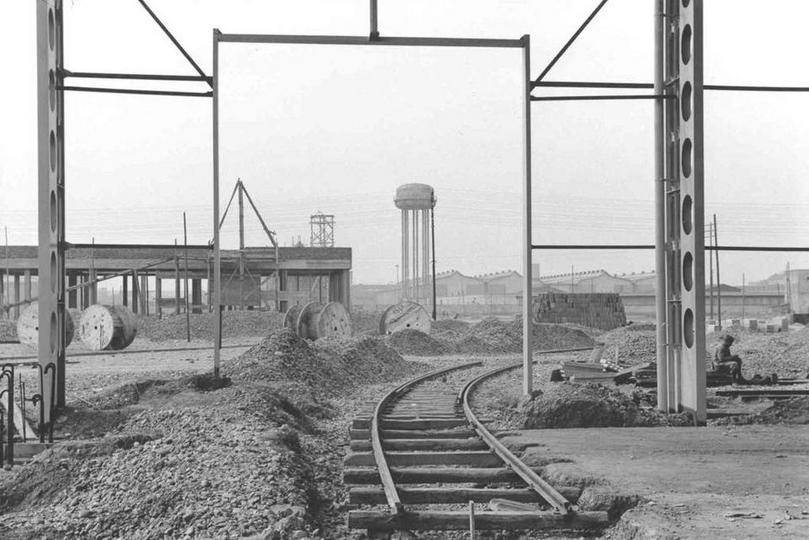



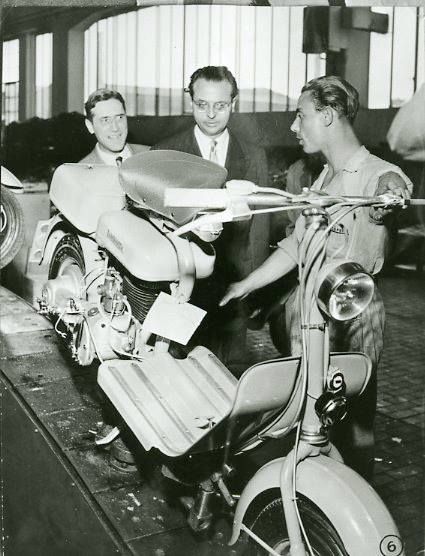
Image Source: I will endeavour to post links to the sites where these images originally featured – and credit any original photographers etc. These images appear to originally come from the Fondazione ISEC Flickr account. The Fondazione ISEC was formed in 1973 for the purpose of collecting, conserving and enhancing sources of the history of the Italian Resistance movement and the labour movement. Over time, Fondazione ISEC has become a national reference point for whoever is interested in events concerning the political, economic and social history of contemporary Italy. They have appeared on various sites, and Pinterest accounts around the internet… hopefully posting them here is another way of preserving and publicising these great images. The Fondazione ISEC site is here: https://www.fondazioneisec.it/
Plenty more to come!
These shots are just the first of many, not only of the Lambretta factory, but also Lambretta trade shows, and various rarely seen publicity shots, as well as images of various Lambretta prototypes etc. Stay tuned for more of this good stuff! Thanks again to Darrin for sourcing and supplying me the images.

Pictures from the Spanish Lambretta Factory in Eibar
A couple of posts back, I wrote about the Lambretta Amiga – the last throw of the dice for the Serveta factory in the Spanish Basque country (here). I gave a short potted history of the Spanish Lambrettas – Reader Darrin Slack got in touch, and shared some fantastic images he had of the Eibar factory (I said he had shared a bunch of great content with me, didn’t I – stay tuned – there’s more to come).The pictures below are of the purpose-built factory that started building scooters in 1954 – just two years after a group of Basque businessmen obtained a licence from Innocenti to build Lambrettas in Spain.




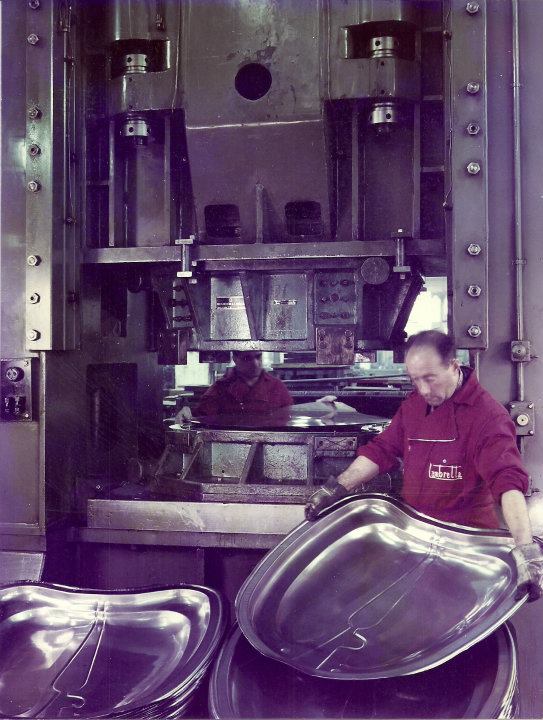




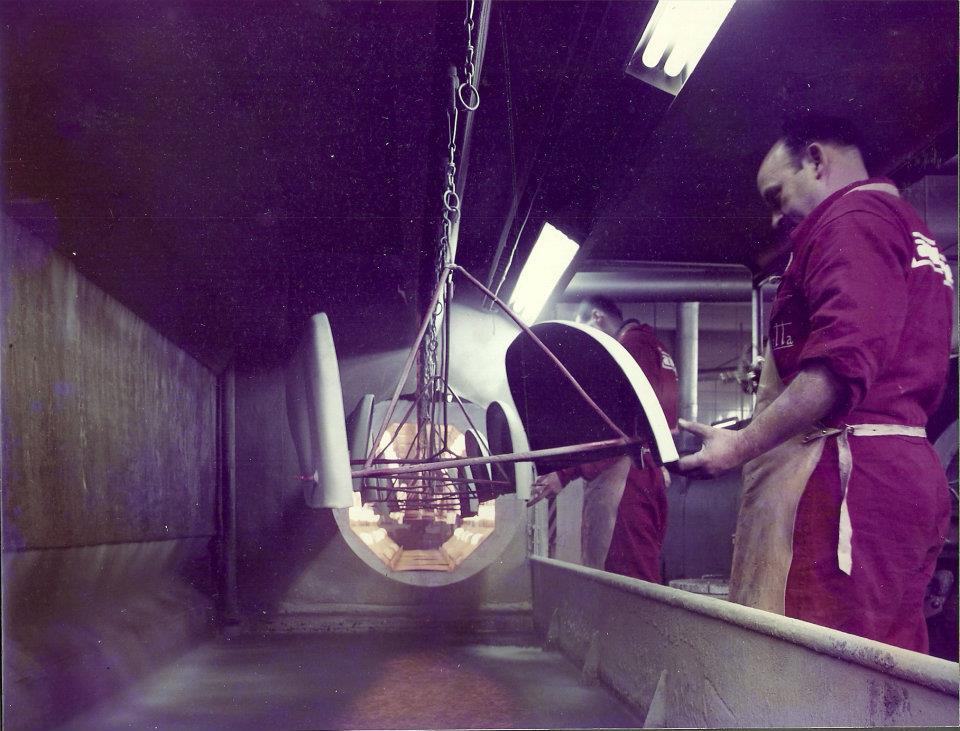
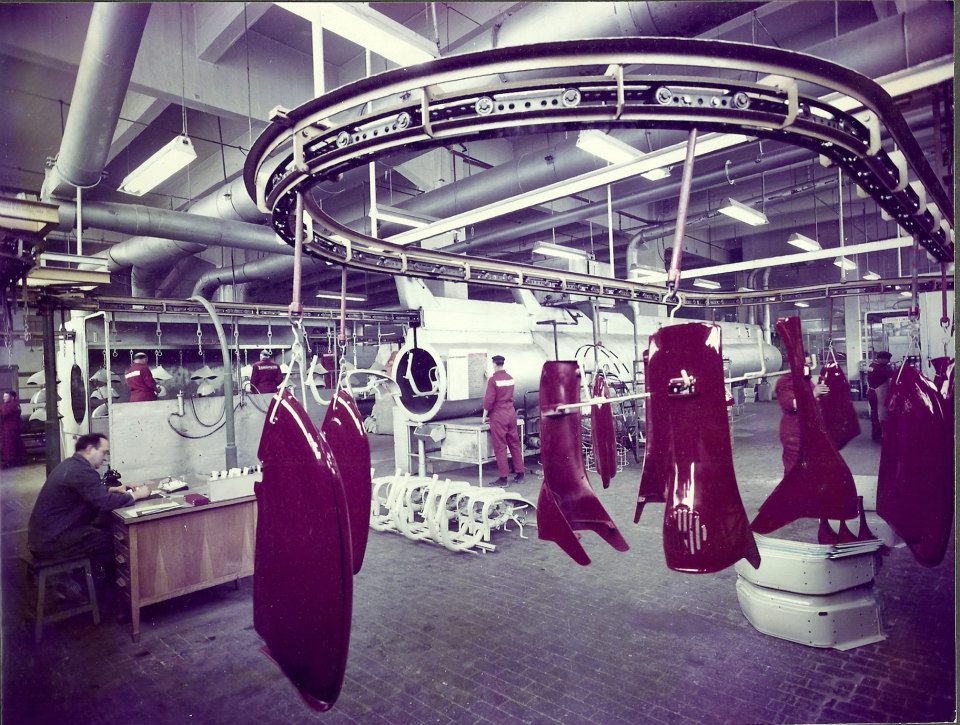
The Basque factory was very successful – initially catering to the domestic Spanish market… as can be seen in the image below, they made at least 3 million machines…

Thanks again to Darrin for the fantastic images. If you’re interested in finding out more about Spanish Lambrettas – check out this site Serveta is Betta.
A couple of weeks ago, I was browsing through the Scooter Restorations site, as I often do when I have a spare ten minutes. I’ve posted a few desirable rare Lambrettas for sale on the blog. Now, I know they specialise in ‘rare’ Lambretta parts, from the model A onwards… But I noticed they had (a few) parts for a Lambretta Amiga. A Lambretta that it never even made it to production. In fact, even pictures of it are rare… although there does appear to be a prototype in the Museo de la Industria Armera in Eibar, Spain. (If the name Eibar doesn’t ring a bell, it probably should, it’s the industrial town in the spanish Basque Country – Euskadi – where Lambretta’s were manufactured (sometimes under the name Serveta).

So it’s rare. We’ve established that. But is it desirable? Well, maybe. But I would hazard a guess at ‘only to a completist’ or only to people really into 80’s/90’s design.
Spanish machines are increasingly sought after in the UK, the Eibar Lambretta Winter Model and Serveta Jet 200 being particularly prized. The last real model to roll off the production line was the Serveta Lince (Spanish for Lynx), which was still very recognisably a Lambretta – albeit – like a 60’s pop star with a facelift and a spray-tan – a Lambretta with a distinctly 80’s make-over.
I wrote about the Lince back in 2013 – here – since then my opinions on many things have mellowed, but sadly not my rather forthright views on the Vespa PX. Anyway I digress. Not like me is it? Back to The Lince. Sadly, although a modest success (over 1,500 made) the Lince was not going to secure the future of Spanish Lambretta production. So it was back the the drawing board, and in 1987, it probably was still designed on a drawing board, CAD being in it’s infancy. I’ll tell you one thing though, they made good use of their rulers that day.
The Amiga was Spain’s attempt to take The Lambretta brand into the ’90s… and one thing you can definitely say of The Lambretta Amiga was that it’s of it’s time. In typical late 80’s fashion anything resembling a sensuous curve was squared off – it was straight lines all the way, baby.
And it wasn’t the only product they had in mind either, there was a rather funky looking trike – The Lambretta Tron – and an Lambro/Vespa Ape type commercial vehicle – The Motocarro Lambretta. The Tron even made it to prototype stage – I can feel another post coming on.

Back to the Amiga. Although it never made it past the prototype stage, there was big talk at the time of The Amiga being “The New Lambretta”. I remember reading an article about it (probably in Scootering) and being absolutely horrified – having a real “What the fuck have they done” moment, and thinking it was like a stormtrooper crossed with a Honda Melody. And not in a good way. (The design of the Honda Melody has aged pretty well, actually, but back in the late 80’s, to any Lambretta or Vespa rider the words Honda and Melody were about the worst insults you could throw at a machine). Anyway. I’ve waffled on far too long. There’s some Amiga bits on eBay, here. Basically, a frame (with some bits bolted on – the fuel tank and the rear shock), the forks and front wheel, and the headset, including the distinctive speedo. There’s no bodywork, seat or engine, although I’d imagine a standard Lambretta/Serveta lump would fit.




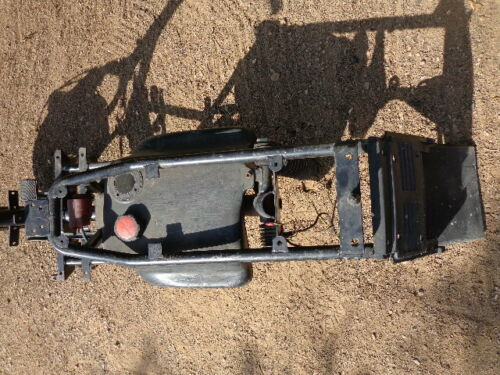


A final note, I’m pretty sure that when I originally looked, Scooter Restorations had an Amiga speedometer in stock. It’s now showing as “out of stock”. Which begs the question… “Who bought it?” and “Why?” Is someone out there building an Amiga? I’d love to know! If it’s you, please get in touch, I love to know more!
I spotted this unique Lambretta Racer on The Bonhams auction site. Scooters have been raced since their earliest days, not the least in Italy – with an especially intense rivalry between Lambretta and Vespa of course!

This particular Lambretta has a unique heritage. Built by Giancarlo Morbidelli (the name behind some of the greatest bikes in smaller-capacity GP racing, who died in February this year in his hometown of Pesaro, Italy). It was put together specifically to compete in the 1994 historical rerunning of the famous Milan-Taranto long-distance road race. Starting life as a Series 1 LI 125, The modifications aren’t listed on the Bonhams site, but they are obviously pretty extensive, just from a quick look at the pictures! If you want a pretty standard machine ‘dressed up’ as a racer, this aint it!

One of four machines entered by the Binova-Cucine team, it was ridden by Giampiero Findanno. He led the race into the final day only to be delayed by an engine seizure; even so, he managed to finish 1st in class and 2nd overall. The Morbidelli-prepared Lambretta was the most talked-about machine in the field, much admired for its technical innovation.
It’s being auctioned with an estimate of £5,000–£10,000 – still carrying its Milan-Taranto competitor’s plates and with a selection of contemporary press cuttings and photographs.
The auction is on 16th August, just a couple of days from when this post is first published.

There’s a walk-around video here
Here’s a link to the Bonhams page.
UPDATE
Scooterlab have written a good follow-up piece on the auction, here. The scooter sold for £7,475 which seems a pretty fair price to me.

I connected with the Michelangelo (now there’s an Italian name for you!), the owner of these two fantastic Model A’s on Reddit – where he posted the picture above. The model A – or Lambretta 125m as was the official designation – it only really became the ‘A’ when the model ‘B’ came along – is where the Lambretta story all began. Documented elsewhere on this site, and around the web, I won’t repeat that all here.

There were only about 9,000 model A’s made, so to have one is pretty special. To have two, is amazing. But to have one as special as Michelangelo’s second one, is very special indeed. No ‘ordinary’ A, this one (an Mk1) features some wonderful period features that elevate it from the standard model to ‘Sport’ or GT spec…
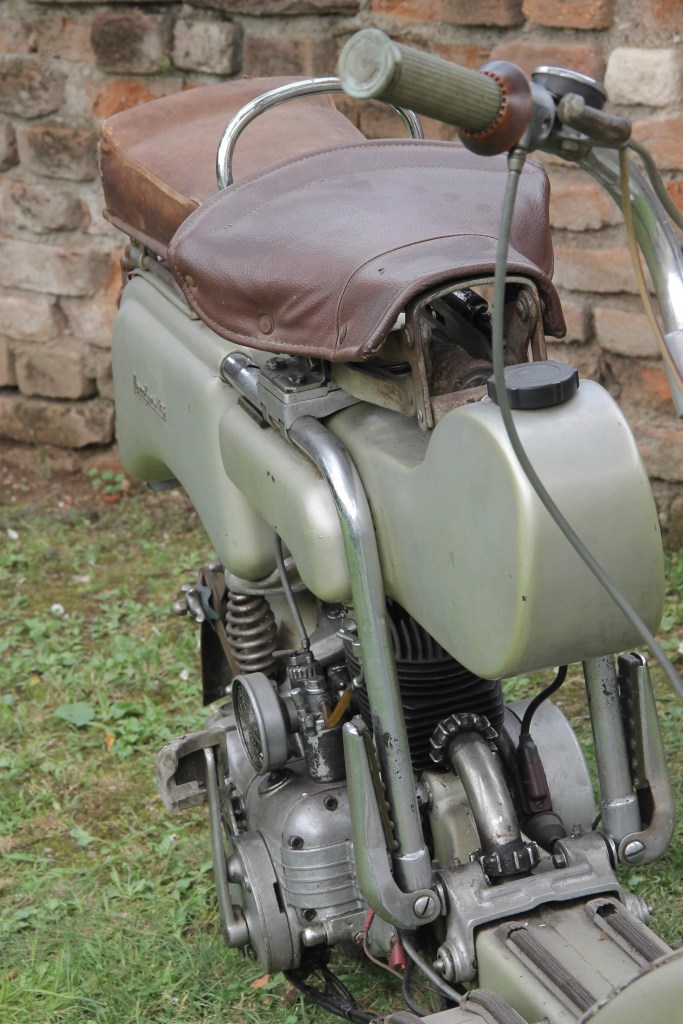
Like something out of a time capsule – some of the differences between a standard A are immediately obvious – such as the elegant long-distance fuel tank. Slightly trickier to spot is the rear suspension – a feature that was felt ‘unnecessary’ on the original model. But not only did this scooter have a rear spring, it appears to height adjustable.
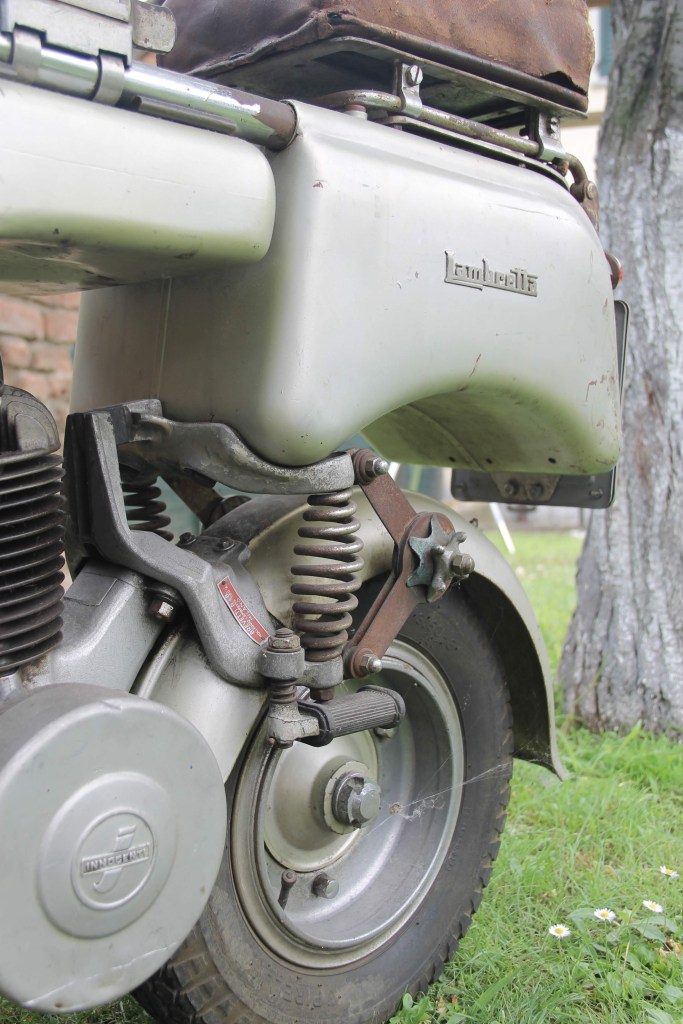
Fitted with a pillion seat – and on this bike you’d need one, as it would be sure to attract admiring glances from pretty young signorinas that you’d want to give a lift to. The aluminum grab rail would give her something to hold on to!

The forks are also ‘specials’ and original to the machine – and give a glimpse of the elegant ‘design language’ of future Lambrettas models. Another contemporaneous modification – made when the scooter was new, or shortly after – is the hand gear change – remember, the A was the only Lambretta model to feature a foot change. So perhaps – who knows – this very scooter helped shape the future of all later Lambrettas?

Scooters like Michelangelo’s A Sport are the reason i do this blog – there is always something new to discover, and interesting people to meet. I love it when people are passionate and knowledgeable about their passion – so if you have pictures of your Lambretta – and it can be any model – and a story to tell about it – I’d love to hear it. You can get in touch here.
A big thank you to Michelangelo Merisi, aka @ilbreizh on Instagram (or Reddit) for sharing these pictures and an important bit of Lambretta history. Michelangelo is currently engaged in another fascinating restoration of another old Lambretta, that I hope to feature on the blog one day. Stay tuned!
Flexible Online Learning
Towards a catalogue of London’s interdimensional gateways
Musings and books from a grunty overthinker
Specialising in Lambretta restorations, repairs & parts
independent scooter magazine
High quality ads for WordPress
They've done the hard work. Can YOU finish it?
Business & Marketing Consultant
Classic Motorcycle Restoration in Scotland
You’ve earned it. You deserve it. Buy it now.
1979 to 1986